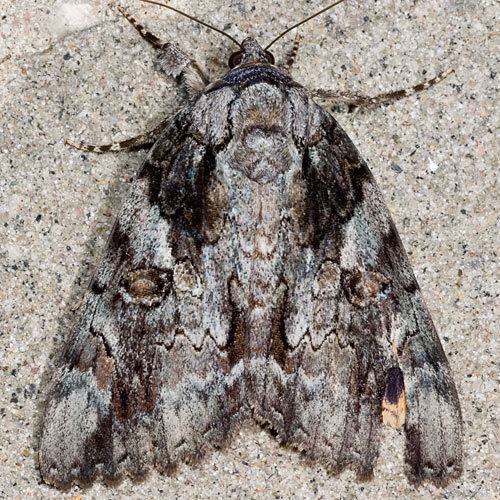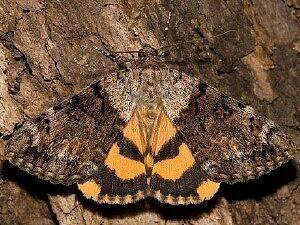Scientific name Catocala Higher classification Catocalinae | Rank Genus | |
 | ||
Lower classifications Red underwing, Catocala fraxini, Catocala sponsa, Catocala fulminea, Catocala ilia | ||
Pink underwing moth noctuidae catocala concumbens in grass
Catocala is a generally Holarctic genus of moths in the Erebidae family. The moths are commonly known as underwing moths or simply underwings. These terms are sometimes used for a few related moths, but usually – especially when used in plural, not as part of a species name – they are used to refer to Catocala only.
Contents
- Pink underwing moth noctuidae catocala concumbens in grass
- Yellow bands underwing catocala fulminea gevlamd weeskind gaume belgium 19 7 2016
- Description and ecology
- Classification
- Synonyms
- Palearctic species
- Nearctic species
- Other underwing moths
- References

Of the more than 250 known species, slightly less than half are found in North America – mostly in the United States – while the rest occur in Eurasia. About one-fifth (almost 30) of these species are native to Europe. A few species occur in the northern Neotropics and Indomalaya.

Yellow bands underwing catocala fulminea gevlamd weeskind gaume belgium 19 7 2016
Description and ecology

Most species of Catocala have medium to large adults, cryptically coloured except for the hindwings, which are marked with stripes in orange, red, white, or even blue. In some, the hindwings are mostly blackish. Unlike what the common name "underwings" seems to suggest, the colour is brightest on the upperside. However, the bright hindwings are not visible at rest, being hidden under the dull forewings – hence the name. Due to their diversity and variety of colors and patterns, underwing moths are popular with collectors of Lepidoptera.
In, The Fauna of British India Including Ceylon and Burma, Moths Vol. II, the genus described as follows.

It is believed that the bright colors, arranged in usually roughly concentric markings, at a casual glance resemble the eyes of a predatory animal, such as a cat. An underwing moth, well camouflaged in its daytime resting spot on a tree trunk or branch, will suddenly flash open the hindwings when disturbed. A bird or other small predator that is not used to this display is likely to be frightened, allowing the moth to escape. However, unlike some other bright-colored moths which are bad-tasting or even poisonous to predators, underwing moths are well palatable at least to some birds (e.g. the blue jay, Cyanocitta cristata). To assist in avoiding nocturnal predators such as bats, these moths also possess (like many of their relatives) fairly well-developed hearing organs.

The caterpillars of most species feed on the leaves of woody plants, usually trees but sometimes shrubs. Typical food plants are Fagales of the families Betulaceae, Fagaceae and Juglandaceae – mainly hickory (Carya), oak (Quercus) and walnut tree (Juglans) species, as well as others such as alder (Alnus), beech (Fagus), birch (Betula) and chestnut (Castanea). The caterpillars of numerous Old World and some North American species feed on the Salicaceae Populus (poplars) and Salix (willows), which belong to the Malpighiales. Less common larval food plants of Catocala are for example elms (Ulmus) and various Rosaceae of the Rosales, Tilia (linden and basswood) of the Malvales, or some Fabaceae of the Fabales; as the preceding, these all belong to the Fabidae lineage of rosid eudicots. More unusually, underwing moth caterpillars have also been found to feed on such plants as maple (Acer) which belongs to a distant lineage of rosids, as well as on such plants as ash trees (Fraxinus) and blueberries (Vaccinium) which are asterids and quite unrelated to the other food plants by eudicot standards.

The adults are predominantly nocturnal, flying from shortly after dusk right up to daybreak. They are generally most active about two hours after nightfall. However, several if not all species of underwing moths have a second activity period exactly around noon, during which they are also regularly found on the wing for about 1–2 hours each day.
The genus name Catocala roughly means "beautiful hindwings". It is a combination of two Ancient Greek words, kato (κάτω, "the rear one" or "the lower one"), and kalos (καλός, "beautiful").
Classification
The species of Catocala are here divided into a Eurasian group, and another one which is found in North America. This does not imply actual relationships; it is mainly done to more conveniently deal with the large number of species. Still, it is not unlikely at all that the groups consist at least to some extent of closely related species.
There are several cryptic species complexes in Catocala, e.g. the group around the Delilah underwing (C. delilah); these and other hitherto unknown species are still being discovered and described in some numbers. Thus, resolving the phylogeny and taxonomy of the underwing moths is an ongoing effort, which has made (as of 2011) little progress. In the scientific literature, smaller subdivisions into putatively related species are sometimes applied, but there is no consistent and widely accepted taxonomic treatment for the genus as a whole.
Synonyms
Several distinct genera have formally been proposed for splitting from Catocala, but these are all treated here as junior synonyms. These synonyms and other invalid names of Catocala are:
Palearctic species
Comparison of Eurasian species
Nearctic species
Comparison of North American species
Other "underwing moths"
As noted in the introduction, some species besides the Catocala species are also commonly known as "underwings". Typically however, the name is used with a qualifier, such as a color term, in these cases. Non-Catocala "underwing moths" are typically owlet moths, namely: Subfamily Catocalinae
Subfamily Amphipyrinae
Subfamily Erebinae
Subfamily Hadeninae
Subfamily Noctuinae
However, the "orange underwings" are two species of genus Archiearis of the geometer moth family (Geometridae):
